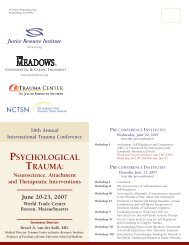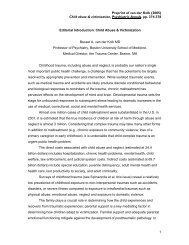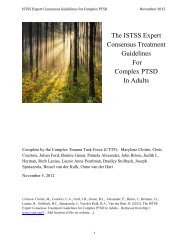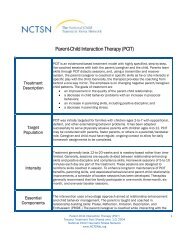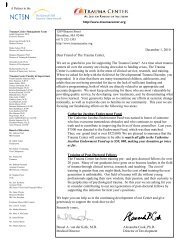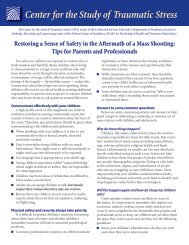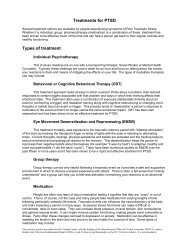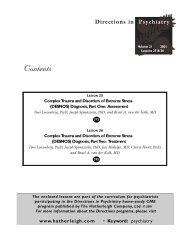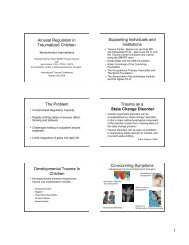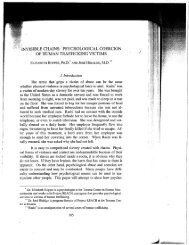in Child Welfare - The Trauma Center
in Child Welfare - The Trauma Center
in Child Welfare - The Trauma Center
Create successful ePaper yourself
Turn your PDF publications into a flip-book with our unique Google optimized e-Paper software.
10 CW360 o <strong>Trauma</strong>-Informed <strong>Child</strong> <strong>Welfare</strong> Practice • W<strong>in</strong>ter 2013Overview<strong>The</strong> Impact of <strong>Trauma</strong>tic Stress on Parents Involved<strong>in</strong> the <strong>Child</strong> <strong>Welfare</strong> SystemErika Tullberg, MPH, MPAThomas is a new caseworker supervis<strong>in</strong>g avisit between his client, Denise, age 25, andher three children, Christopher, Jr., age 5,Tanya, age 3, and Damon, age 2. This visithas already been rescheduled twice – it wassupposed to happen after the agency’s weeklydomestic violence group, which Denise ismandated to attend as part of her service plan,but she keeps miss<strong>in</strong>g the meet<strong>in</strong>gs. Thomaswants to talk to Denise about how she needsto come to these groups if she wants her kidsback, but he has seen her temper and doesn’twant to do anyth<strong>in</strong>g to make today’s visit gobadly so decides to let it go.Damon has not said anyth<strong>in</strong>g s<strong>in</strong>cearriv<strong>in</strong>g at the agency; he is still strapped<strong>in</strong>to his stroller and s<strong>in</strong>ce com<strong>in</strong>g <strong>in</strong>tothe visitation room has been wh<strong>in</strong><strong>in</strong>g andreach<strong>in</strong>g up to Denise, but she keeps tell<strong>in</strong>ghim to “behave” while she tries to get hissibl<strong>in</strong>gs to settle down. After a few m<strong>in</strong>utesof runn<strong>in</strong>g around Christopher trips on hisshoelaces and starts bleed<strong>in</strong>g from his head –Tanya shrieks when she sees the blood, andDenise yells at Christopher say<strong>in</strong>g that he’sru<strong>in</strong>ed the visit and is always out of control,just like his father. Thomas goes to comfortTanya, who has started to shake and cryuncontrollably, but Denise steps <strong>in</strong> front ofhim say<strong>in</strong>g that she can handle her kids andthat they don’t need his help.<strong>The</strong> child welfare system has become<strong>in</strong>creas<strong>in</strong>gly attuned both to the traumathat children and youth <strong>in</strong> the systemhave experienced and to the importance ofaddress<strong>in</strong>g such trauma as part of ensur<strong>in</strong>gtheir safety, permanence and well-be<strong>in</strong>g(Kisiel, Fehrenbach, Small, & Lyons, 2009).Research on the impact of trauma on fostercare placement stability <strong>in</strong> the short term,and long-term health outcomes over thelifespan, has helped to spur <strong>in</strong>creased tra<strong>in</strong><strong>in</strong>gon trauma for staff, resource parents, andother system stakeholders and availability ofevidence-based <strong>in</strong>terventions for children andyouth (Landsverk, Garland, Reutz, & Davis,2011).However, we know that for children <strong>in</strong> thechild welfare system, the trauma they haveexperienced has often happened at home:abuse or neglect from a caretaker, exposureto domestic violence, or separation from aparent due to homelessness, <strong>in</strong>carceration orother family stressors. For parents who grewup under similar circumstances, or who haveexperienced traumatic events <strong>in</strong> adulthood, itmay be difficult to provide their own childrenwith support and structure if their owntrauma rema<strong>in</strong>s unaddressed. Research hasdemonstrated, <strong>in</strong> fact, that a parent’s traumahistory may <strong>in</strong>crease his or her children’srisk of maltreatment (Banyard, Williams, &Siegel, 2003; Cohen, Hien, & Batchelder,2008), and that the parent’s trauma-relatedsymptoms and ability to respond <strong>in</strong> aprotective manner to his or her children isa predictor of a child develop<strong>in</strong>g traumasymptoms follow<strong>in</strong>g exposure to a traumaticevent (Chemtob, Nomura, & Abramovitz,2008). If parents do not feel safe, they will beless able to keep their children safe.Anecdotal evidence and grow<strong>in</strong>g researchsuggests that trauma is very common amongparents receiv<strong>in</strong>g child welfare services. InNew York City, the ACS-NYU <strong>Child</strong>ren<strong>Trauma</strong> Institute’s Safe Mothers, Safe<strong>Child</strong>ren program is address<strong>in</strong>g traumaexperienced by mothers receiv<strong>in</strong>g child welfarepreventive services. Dur<strong>in</strong>g project plann<strong>in</strong>g<strong>in</strong>terviews conducted <strong>in</strong> 2008, East Harlempreventive service program directors reportedconcerns about trauma experienced by theirclients, cit<strong>in</strong>g related problems with theirability to have patience with, empathy for,and express affection towards their children.Dur<strong>in</strong>g subsequent screen<strong>in</strong>gs with mothersreceiv<strong>in</strong>g services from a subset of theseagencies, 92 percent reported at least oneprior traumatic experience with the averagebe<strong>in</strong>g 2.6 categories of traumatic events. Fiftyfourpercent of mothers met probable criteriafor post-traumatic stress disorder, 62 percentmet probable criteria for depression, and 49percent met probable criteria for both PTSDand depression (Chemtob, Griff<strong>in</strong>g, Tullberg,Roberts, & Ellis, 2011).Research has shown that parents withhistories of trauma can be harder to engage<strong>in</strong> services and have difficulty trust<strong>in</strong>g serviceproviders (Kemp, Marcenko, Hoagwood,& Vesneski, 2009; Dawson & Berry,2002). Despite this and the prevalence oftrauma among parents <strong>in</strong> the child welfaresystem, our experience is that it is relativelyFor parents who grew up under similar circumstances, or who haveexperienced traumatic events <strong>in</strong> adulthood, it may be difficult to providetheir own children with support and structure if their own traumarema<strong>in</strong>s unaddressed.uncommon for parents to receive traumaspecificscreen<strong>in</strong>g, much less trauma-<strong>in</strong>formedmental health services – and many childwelfare staff are not tra<strong>in</strong>ed to recognizetrauma symptoms and how trauma canimpact parent<strong>in</strong>g and child safety. As a result,child welfare staff may be more likely toregard parents like Denise as non-compliant,disengaged, detached from their children,angry and defensive.How else could Thomas understandDenise, the decisions she’s mak<strong>in</strong>g, and howshe responds to her children? How can he usethat knowledge to help her? With the benefitof a “trauma lens,” the above scenario couldbe reframed as follows:• Ask questions. Caseworkers are oftenworried that ask<strong>in</strong>g clients detailedquestions about their past traumaticexperiences may cause their clients to




